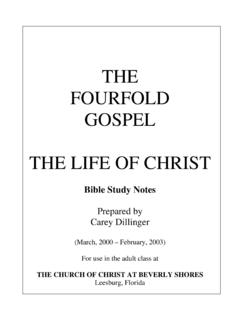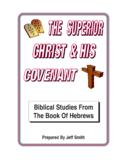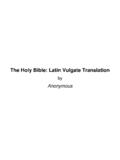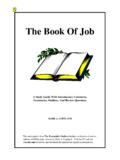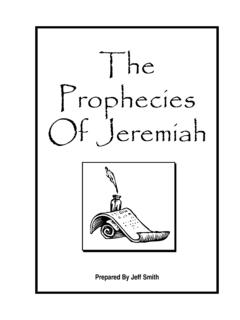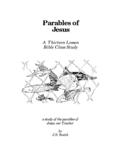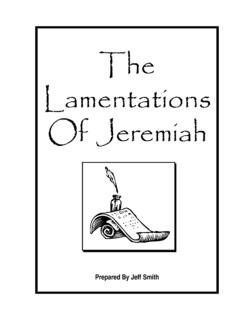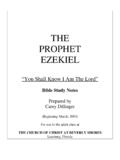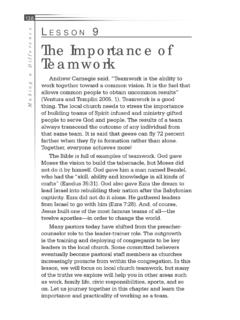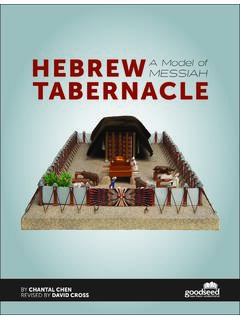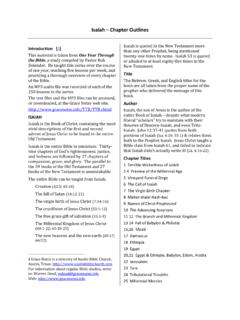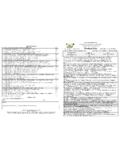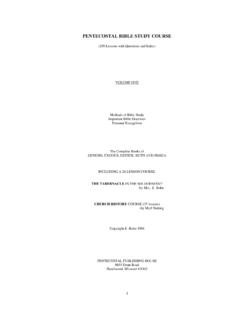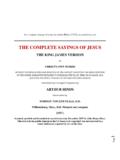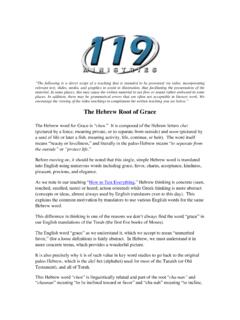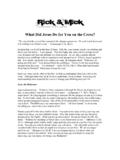Transcription of Biblical Typology - Bible Study Guide
1 A Study on types and antitypes, the divinely sewn thread that runs through the SmithBiblical TypologyA Thirteen LessonBible Class StudyIntroductionTypology is a magnificent piece of evidence which helps to show the divinely sewn thread that runs throughout the Bible . In so many significant New Testament examples, we see them foreshadowed in great moments and characters in the Old the type and antitype relationship is properly understood, it becomes a valuable faith builder. One must use caution, however, and not take this mechanism too 1 Biblical Typology : IntroductionTYPEANTITYPET ypology Involving PeopleLesson 2 Abraham and IsaacJehovah and JesusLesson 3 The Fall of AdamRedemptive Work of ChristLesson 4 Jonah in the FishBurial and Resurrection of ChristTypology Involving OfficesLesson 5 MelchizedekHigh Priesthood of ChristLesson 6 AaronPriesthood of BelieversTypology Involving EventsLesson 7 Fleshly IsraelSpiritual IsraelLesson 8 Deliverance from EgyptDeliverance from SinLesson 9 Wilderness WanderingLifeLesson 10 Conquest of CanaanReaching HeavenLesson 11 Noah s ArkBaptism and SalvationBrazen SerpentFaith and SubmissionTypology Involving InstitutionsLesson 12 TabernacleHeavenLesson 13 Old CovenantNew CovenantLesson 1.
2 Biblical TypologyIn his seminal work, Hermeneutics, brother Dungan classifies Typology as a figure of thought rather than a figure of speech (page 346). They differ from metaphors and parables in that they are reflected not by a turn of phrase, but by a relationship foreseen by the almighty and merely hinted at until Typology involves two separate subjects, a type and an antitype. The type is a person, institution, office or event that proves suggestive of some superior object in the plan of God. This latter object is thus called its antitype, and the link which binds them together is the correspondence, the similarity, of the one with the other (International Standard Bible Encyclopedia, page 3029).The most frequently cited example of Typology involves Isaac and Jesus. Isaac is typical of Jesus (his antitype) in that both were only sons of promise who were objects of sacrifice for their word type is derived from the Greek tupos ( ), which is defined as a blow or mark left by a blow; a pattern or impress (Unger s Bible Handbook, page 7).
3 Unger states that Typology involves a double representation in action, the literal being intended and planned to represent the spiritual (Ibid). The Greek root appears 16 times in the New Testament, variously translated as print, figure, pattern, fashion, form or example, yet one general idea is common to all, namely, likeness (ISBE, page 3029). Typology is one means by which God weaves together the scheme of salvation from Genesis to the incarnation of His son, all the while leaving visible the evidence of His vigilant mastery. William G. Morehead, in an article for the International Standard Bible Encyclopedia, explains that a type must have three well-defined qualities to be considered a type. First, it must be a true picture of that which it represents or prefigures.
4 A type is a draft or sketch of some well-defined feature of redemption and therefore it must in some distinct way resemble its antitype. Second, the type must be by divine appointment. Some have endeavored to make everything in the Old Testament typical of something in the New Testament, but this is going too far. Typology will show the obvious fingerprint of God. Third, a type always prefigures something in the future and never in the describe differently the classifications of Typology , but for our Study , we will consider there to be four: people, events, offices and Old Testament characters were typical of Jesus christ in one or more ways. Adam, Moses, and Joshua all had characteristics that ultimately proved suggestive of the son of God. They were not perfect representations of the Messiah, but had qualities or did things that the Lord would.
5 Elijah was a type of John the are also several great events in the Old Testament that proved typical of some greater thing in the New Testament. The best example is the relationship between Israel s Exodus and the liberation of sinners from slavery to the devil by God s redemption. The office of Melchizedek was typical of christ s high priesthood. The priesthood of Aaron came to be typical of the New Testament priesthood of all baptized believers. The throne of David is suggestive of the authority of christ over his spiritual Testament institutions that answer to New Testament antitypes include the temple, the tabernacle and the city of , the hardest task is to determine what is Typology and what is not. The extreme view that makes every incidental thing a type is dangerous and can lead to bizarre conclusions.
6 Some have gone so far as to make the 153 fish caught by the disciples the night the risen christ appeared to them a type of all sorts of things. Such an extreme is arbitrary and fanciful; it tends to destroy the validity and trustworthiness of the record (ISBE, page 3029). A healthy dose of common sense and restraint are helpful in studying Biblical Typology11. What are the two components of Biblical Typology ? Which necessarily is reported first? Typology is composed of a type and an antitype. The type always precedes the antitype in Biblical What is the link that binds these two components together? The link which binds them together is the correspondence, the similarity, of the one with the other. The likeness of the two and God s divine intention makes them What is the most frequently cited example of Biblical Typology ?
7 Isaac is typical of Jesus, in that both were only begotten sons whose fathers were willing to sacrifice Define the Greek root word tupos. Explain how this ancient definition applies to Biblical Typology . The Greek word tupos means a blow or mark left by a blow; a pattern or impress. This word is clearly applicable in that God strikes a blow with the type and leaves an imprint or reflection of the antitype yet to How is tupos translated in the New Testament? The word tupos is translated print, figure, pattern, fashion, form or Briefly list the three qualities a figure of thought must possess to be considered an example of Typology , according to First, it must be a true picture of that which it represents or prefigures. A type is a draft or sketch of some well-defined feature of redemption and therefore it must in some distinct way resemble its antitype.
8 2. Second, the type must be by divine appointment. Some have endeavored to make everything in the Old Testament typical of something in the New Testament, but this is going too far. Typology will show the obvious fingerprint of God. 3. Third, a type always prefigures something in the future and never in the What are the four basic classifications of Typology for the purposes of this series of studies? Give one example of each. Try to think of one not mentioned in the class people (Isaac/Jesus)2. events (Exodus/redemption)3. offices (Melchizedek/ christ , Aaronic priesthood/New Testament priesthood of believers)4. institutions ( tabernacle /heaven, temple/church)8. What is an example of going too far in identifying an alleged Biblical type? Some try to make every incidental thing in the Bible typical of something else. This attitude leads to fantasy and a hindrance to Biblical credibility.
9 SmithLesson 2: Abraham and Isaac For God so loved the world that He gave His only begotten Son, begins the famous passage of John 3:16. The great patriarch also had an only begotten (legitimate) son whom he was willing to sacrifice. When Abraham took his son Isaac out to be sacrificed, God imprinted upon the book of Genesis a sketch of the sacrifice of christ , which would be fully accomplished, proving the axiom, The Lord will provide has deep spiritual Read Genesis 22:1-19. What exactly does Jehovah instruct Abraham to do in verse 2? God tells Abraham to take his only son Isaac, whom he loved, to Moriah and offer him as a burnt How did Abraham respond to this odd command? Was he willing to watch his own son die? Why or why not? Abraham arose early the next morning and saddled his donkey to take Isaac and his servants to Moriah.
10 He also took wood for the offering. On the third day, he saw the place in the distance and told the servants to wait while he and Isaac went to worship. Abraham was willing to watch his son die for he knew it was God s will and that God would somehow provide him an How do we know that God was likewise willing to allow Jesus to die? (Give scripture to support your answer.) John 3:16 tells us that God so loved the world that He willingly gave Jesus as a sacrifice to remit the sins of the How many people did Abraham expect to return from this worship service? More than one, for he said, we (Isaac and he) will Who transported the wood to the place of sacrifice? What did Abraham carry? Isaac carried the wood while Abraham carried the fire and the Who transported part of the way the wood upon which christ was sacrificed (John 19:17)? Jesus bore his own cross part of the way to What does Paul say of the significance of that wood in Galatians 3:13-14?
